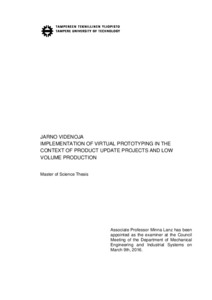Implementation of virtual prototyping in the context of product update projects and low volume production
Videnoja, Jarno (2016)
Videnoja, Jarno
2016
Konetekniikan koulutusohjelma
Teknisten tieteiden tiedekunta - Faculty of Engineering Sciences
This publication is copyrighted. You may download, display and print it for Your own personal use. Commercial use is prohibited.
Hyväksymispäivämäärä
2016-05-04
Julkaisun pysyvä osoite on
https://urn.fi/URN:NBN:fi:tty-201604043774
https://urn.fi/URN:NBN:fi:tty-201604043774
Tiivistelmä
The aim of this master’s thesis was to discover whether virtual prototyping could be utilized in a forest machine company’s product update projects to support the cooperation between design and production departments. The goal was to develop and evaluate an implementation method for virtual prototyping during design phases, which would make the current development process more efficient by reducing the amount of resources spent in physical prototyping in future product update projects. This thesis is part of a jointly funded research project.
In the theoretical part of the thesis a literature review considering product development, concurrent engineering, prototyping, and virtual reality technology was undertaken. In addition virtual prototyping, its previous applications, and its impact and requirements on organizational and individual level were researched, providing the theoretical framework for the thesis.
The practical part of the research included an analysis of the case company based on the literature review, materials produced during the jointly funded project, and qualitative interviews with 10 employees of the case company. The aim was to become acquainted with the case company’s product development process, current design reviews and communication between design and production departments. As a result, an implementation method for virtual prototyping was developed, which concentrated on the evaluation of assembly properties in collaborative design reviews.
The implementation method was tested in one product update project by organizing a collaborative design review and by demonstrating the benefits of virtual prototyping at a virtual reality test facility. An inquiry along with observation and open discussion were utilized to collect feedback about the performance of the implementation method and virtual prototyping in evaluation of assembly properties. The results indicate that the company saw potential in virtual prototyping utilizing collaborative design reviews. As a result, these design reviews will be partly applied in future product upgrade projects. Evaluation of assembly properties was seen as a successful implementation target. The main shortcomings for comprehensive application of virtual prototyping were the need for optimization of 3D models and the product data management’s current status in the case company, which currently does not support the implementation method as well as it could. To gain results from the practical benefits of virtual prototyping, it should be further implemented during future product update projects as a whole.
In the theoretical part of the thesis a literature review considering product development, concurrent engineering, prototyping, and virtual reality technology was undertaken. In addition virtual prototyping, its previous applications, and its impact and requirements on organizational and individual level were researched, providing the theoretical framework for the thesis.
The practical part of the research included an analysis of the case company based on the literature review, materials produced during the jointly funded project, and qualitative interviews with 10 employees of the case company. The aim was to become acquainted with the case company’s product development process, current design reviews and communication between design and production departments. As a result, an implementation method for virtual prototyping was developed, which concentrated on the evaluation of assembly properties in collaborative design reviews.
The implementation method was tested in one product update project by organizing a collaborative design review and by demonstrating the benefits of virtual prototyping at a virtual reality test facility. An inquiry along with observation and open discussion were utilized to collect feedback about the performance of the implementation method and virtual prototyping in evaluation of assembly properties. The results indicate that the company saw potential in virtual prototyping utilizing collaborative design reviews. As a result, these design reviews will be partly applied in future product upgrade projects. Evaluation of assembly properties was seen as a successful implementation target. The main shortcomings for comprehensive application of virtual prototyping were the need for optimization of 3D models and the product data management’s current status in the case company, which currently does not support the implementation method as well as it could. To gain results from the practical benefits of virtual prototyping, it should be further implemented during future product update projects as a whole.
